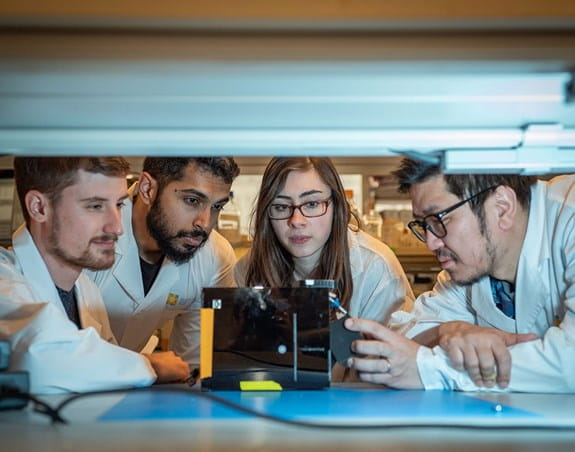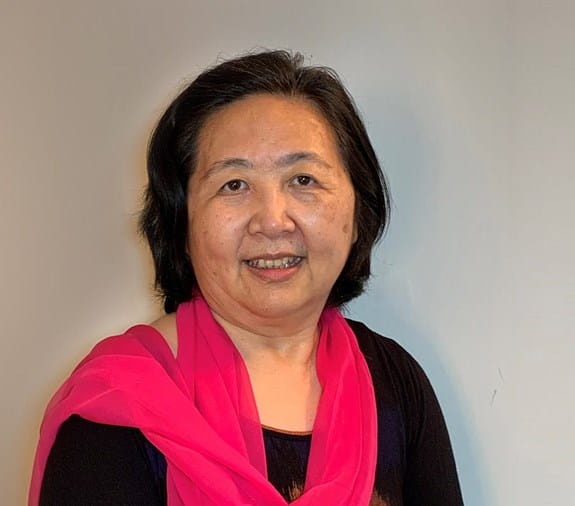
Our research strategy
There has never been a more exciting and hopeful time for cancer research. Our research strategy to 2027 reflects a bold approach to funding and conducting research – one that puts people at its core.
Our research vision
Our vision for research is to fund a deliberate portfolio of scientifically excellent, high-performance research that improves cancer outcomes and addresses the greatest opportunities for progress.
We have been funding outstanding research since 1947, and as the largest cancer charity in Canada, we are uniquely positioned to drive life-changing advances that benefit all people in Canada.

Our grounding principles
Working in consultation with a broad community of researchers, staff, volunteers, people with lived experience of cancer, cancer control and healthcare partners and more, we identified grounding principles that provide a foundation for our research strategy. By working from these principles, we set an ambitious direction forward with people at the core.
Our research strategy
[A map of Canada centred on the screen appears.]
Words on screen: Canada 1.5 million people
Voice-over (VO): Right now, 1.5 million people in Canada are living with or beyond cancer. To save and improve their lives, research is the key.
[The text fades away and the outline of the map dynamically changes into the outline of a close-up of two people holding hands with one another.]
VO: As Canada’s largest charitable funder of cancer research, the Canadian Cancer Society seeks out the very best science.
[The Canadian Cancer Society logo appears on screen]
[Four researchers in white coats are working in a lab on the left side of the screen. On the right side of the screen, a group of people in a focus group are sitting on chairs in a circle having a discussion. The leader of the focus group is holding a clipboard and taking notes.]
VO: Our rigorous review process ensures the most promising ideas are supported wherever they are in the country and for every cancer type.
[Four people are sitting in a boardroom at a table looking at their laptops. The people are actively working on the laptops. Scores (between 0 to 5 stars) appear from each laptop one-by-one and then disappear before another score appears. This continues until the end of the scene.]
[A map of Canada appears, and people pop up throughout the country. They different races, gender identities and body types. Each one represents a different cancer type.]
VO: Our research strategy puts people at the core and aims to make progress toward four goals.
[Four icons appear on the screen. Below each icon, the corresponding words on the screen appear:
Prevent
Detect
Care
Champion.]
[The bud of a daffodil appears in the centre of the screen. It blooms and fills more of the screen. The camera zooms out to show the daffodil in a field of many other daffodils. A group of five diverse people appear in the shot]
VO: Together, we can change the future of cancer and create more tomorrows with the people we love.
[A yellow background and the Canadian Cancer Society’s logo appears in the centre of the screen.]
Words on the screen below the logo: Help fuel world-class research in Canada.
Learn more and donate today:
cancer.ca/research
Our Goals to 2040
The rate of new cancer cases has decreased annually since 2011, thanks in part to evidence-based policies, practices and interventions that support healthy living and access to screening that can detect cancer before it starts. Through research on new ways to reduce cancer risk and detect it before it starts, we are building on this progress to drive further declines in the cancer incidence rate.
Currently, prevention and early detection strategies are not distributed equitably across the country. Effectively preventing cancer will also require capacity-building and new strategies tailored to the many distinct populations and environments that represent Canada’s current and growing population.
In most cases, the earlier a cancer is diagnosed and treated, the more likely it is that treatment will be successful.
Over the last 4 decades, we have seen significant declines in mortality rates for all cancers combined, in part because of our increased ability to detect cancers early.
For example, the majority of breast and prostate cancer cases – 2 of the most common cancer types – are now diagnosed at stages 1 and 2, contributing to decreases in mortality of 46% for breast cancer and 50% for prostate cancer since their peaks in 1986 and 1995 respectively.
But these improvements in early diagnosis are not reflected equally across all communities or cancer types. People facing certain cancers, such as brain, esophageal, liver, lung, pancreatic and stomach cancers, are often diagnosed later because symptoms may not be easily detectable early on. These cancers are often found when they have started to spread, making treatment much more challenging. Even for the cancers that can be caught early, like some breast and prostate cancers, there is still more we need to do to improve screening and diagnosis to prevent deaths and enhance quality of life for people affected by these cancers in Canada.Other complex factors influence how early cancer is caught, including timely access to appropriate health services and care, and the existence, availability and level of participation in screening programs. For these reasons, reaching a goal of having fewer people diagnosed at later stages is a formidable but crucially important challenge.
More than 70% of cancer survivors experience significant physical and emotional challenges after treatment.
The growing number of people in Canada who are living with and after cancer has spurred activity in cancer survivorship research and fuelled research to find solutions to improve quality of life. As our understanding of cancer biology has increased, so too has our ability to provide more precise and effective treatments with fewer side effects. This progress applies equally to the mainstays of cancer treatment – surgery, radiation and chemotherapy – as well as to relatively new approaches such as immunotherapy and radioligand therapy.
We must continue to push forward. In addition to our longstanding commitment to funding clinical trials, we need to develop new and more precise therapies to prevent people from dying of cancer while also discovering ways to reduce the adverse side effects of treatment so people can live long, healthy lives
Cancer prevention strategies, screening, diagnosis, treatments and survival are not equitably distributed among Canada’s diverse populations. These inequities historically excluded populations such as members of the Black, Indigenous and people of colour community as well as those experiencing racism, homelessness, physical disabilities and mental health challenges. Effective cancer control requires targeted strategies to engage and co-create with the many distinct populations that make up Canada.
This need is driving a new era of how we conduct health research for maximum impact – one that focuses on implementation research, cost-effectiveness studies, integrated knowledge translation and mobilization, and the involvement of people living with cancer and the public as partners in the research process.
At the same time, we must invest in health services and economics research that benefit all individuals and communities in Canada, driving cost-effective approaches and building the case for their uptake by the cancer prevention and care system. We will strive to ensure that all people living in Canada are able to benefit from the best prevention strategies, scientific breakthroughs and models of care available.
Our integrated approach
To drive impact and achieve our goals, we are uniting research and action to directly address the changing needs of all communities. We will implement cross-cutting approaches to guide the research we support, making it more relevant to those we serve and accelerating research outcomes into life-changing impact.
These are a few of our integrated approaches.
Working with partners with lived cancer experience, we have co-developed a patient engagement strategy in cancer research funding that will ensure the voices of people affected by cancer are embedded in decision-making and capacity-building across our research programs. By championing patient leadership and supporting patients as co-creators within our processes, we are reframing our traditional research approaches through the lens of patients to make our research truly relevant to the communities we serve..
We will engage partners beyond the patient community – such as research funders, cancer agencies/foundations and industry – to broaden our reach, fill gaps in research knowledge and expertise, connect directly with end users and leverage our investments to fund more grants. We will involve partners early to co-create research programs, maintaining transparency, communication and flexibility, and work together to ensure our shared goals are met for the benefit of people’s health.
As a partner in research, we will re-imagine the funder-researcher relationship and enhance and expand opportunities for mutual benefit. For example, we will elevate the profile of CCS-funded researchers through networking events and facilitate collaboration and dialogue among researchers, people affected by cancer, the public and donors. We will continue to engage the research community as advisors and reviewers and increase our efforts to promote the diverse researchers we fund and tell stories about their accomplishments that engage and resonate with the general public.
We will facilitate and expedite the movement of research discoveries and innovations into policy and practice so they can directly benefit people affected by cancer. We will support knowledge translation and mobilization by creating opportunities for researchers to work together with end users such as healthcare professionals, policy makers, patients and caregivers. We will be a true partner in research with our research community, celebrating their success and creating opportunities to share their research progress. This will enable us to help solve problems, build networks and greater public participation in cancer research, and contribute to scientific literacy among patients and the public.
We will expand our support for the next generation of cancer researchers in smaller provinces, so that research progress is sustained for years to come. By investing in the recruitment and training of emerging scholars and instilling the value of patient engagement and inclusivity, we will work with universities, hospitals and research institutions to lay the foundation for a diverse and inclusive research workforce. This will open the door to greater and more diverse contributions that strengthen the future of Canada’s cancer research ecosystem.
We will continue to build on our Research Inclusive Excellence Action Plan, first released in 2020, to ensure our research funding reflects inclusive excellence and our funded researchers consider the potential for greater equity in their processes and outputs. We will work to become a leader in the charitable sector in the promotion of inclusive excellence across our research funding and awards programs – from program development to results. We will work with our partners to ensure that there is greater representation among cancer research participants – from expanding access to clinical trials to engaging with diverse patient communities as partners in research. We will make specific investments in researchers who are under-represented, such as Black and Indigenous researchers, and we will continue to learn, assess and evolve our plans as we work toward achieving equitable outcomes for everyone affected by cancer.

“For patients, research brings hope. Researchers are the experts in researching and treating cancer, and cancer patients are the experts living with cancer and we bring a different perspective to research. Only by working together can we transform cancer.”
Christine Qiong Wu, CCS Patient/Survivor Caregiver Reviewer
Evaluating progress
What does success look like?
In addition to achieving our 4 goals – prevent, detect, care and champion – we will transform research to have maximum impact by:
- Involving patients, caregivers and survivors meaningfully in all aspects of research – from setting priorities to participating in research studies and evaluating outcomes
- Aligning a cancer research portfolio with patient and healthcare system positioned to make meaningful changes to cancer control policies, practices and programs
- Building a productive, collaborative and supportive CCS research community that reflects and leverages Canada’s diversity and meaningfully includes patients, caregivers, survivors and partnerships from conception to implementation
- Creating diverse and impactful partnerships that help to extend the breadth, scope and reach of research funded by CCS and our partners
- Supporting a pipeline of disruptive cancer innovations that aims to improve the cancer experience
Help fund world-leading cancer research
With almost half of all Canadians expected to face a cancer diagnosis in their lifetime, the urgency for funding is at an all-time high. Research holds the key to transforming the future of cancer.
If everyone reading this joins our monthly donor community today, we can keep up the momentum for life-changing discoveries to better detect, diagnose and treat all types of cancer.
Please donate today because every contribution counts.
